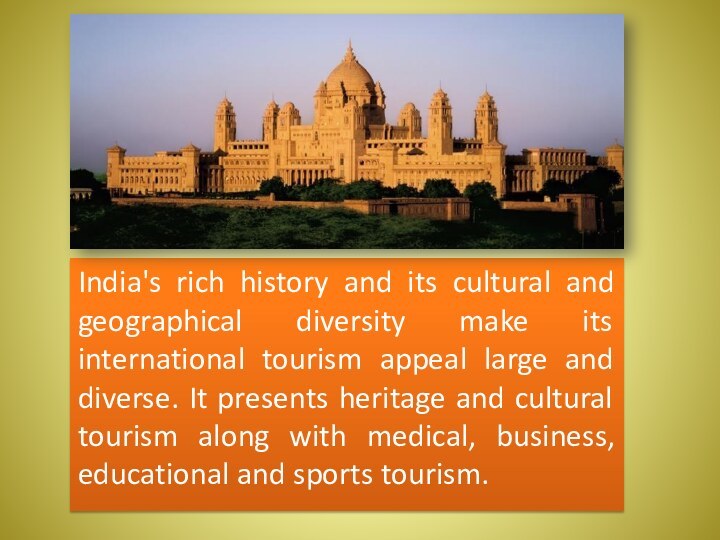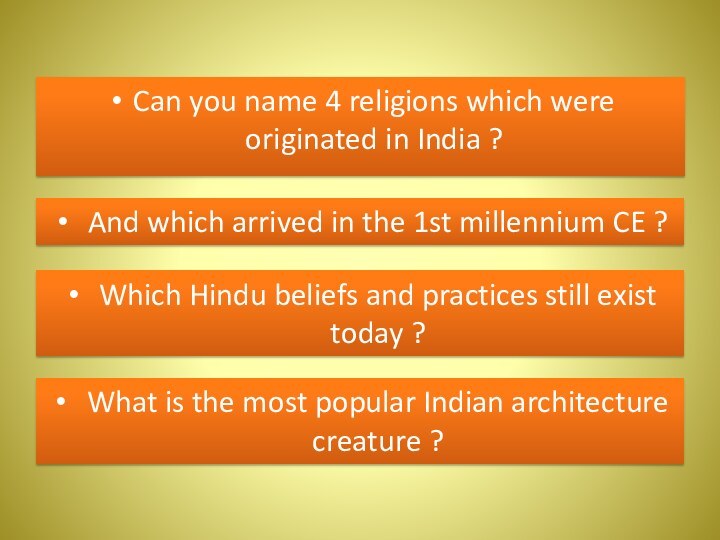- Главная
- Разное
- Бизнес и предпринимательство
- Образование
- Развлечения
- Государство
- Спорт
- Графика
- Культурология
- Еда и кулинария
- Лингвистика
- Религиоведение
- Черчение
- Физкультура
- ИЗО
- Психология
- Социология
- Английский язык
- Астрономия
- Алгебра
- Биология
- География
- Геометрия
- Детские презентации
- Информатика
- История
- Литература
- Маркетинг
- Математика
- Медицина
- Менеджмент
- Музыка
- МХК
- Немецкий язык
- ОБЖ
- Обществознание
- Окружающий мир
- Педагогика
- Русский язык
- Технология
- Физика
- Философия
- Химия
- Шаблоны, картинки для презентаций
- Экология
- Экономика
- Юриспруденция
Что такое findslide.org?
FindSlide.org - это сайт презентаций, докладов, шаблонов в формате PowerPoint.
Обратная связь
Email: Нажмите что бы посмотреть
Презентация на тему Republic of India
Содержание
- 2. HISTORYHome to the ancient Indus Valley Civilisation and a
- 3. Gradually annexed by and brought under the
- 4. CULTUREIndian cultural history spans more than 4,500
- 5. Much of Indian architecture, including the Taj Mahal, other
- 6. In India, several traditional indigenous sports remain
- 7. TOURISMThe tourism industry of India is economically important and is growing rapidly.
- 8. The Ministry of Tourism designs national policies for the
- 9. India's rich history and its cultural and
- 10. ECONOMYMumbai is the commercial and entertainment capital
- 11. India's telecommunication industry, the world's fastest-growing, added 227
- 12. Here is a short review about India:
- 13. Let’s see if you remember something from this presentation…
- 14. Can you name 4 religions which were
- 15. What is the name of tourism campaign
- 16. Скачать презентацию
- 17. Похожие презентации
















Слайд 3
Gradually annexed by and brought under the administration
of the British East India Company from the early 18th century
and administered directly by the United Kingdom after Indian Rebellion of 1857, India became an independent nation in 1947 after a struggle for independence that was marked by non-violent resistance led by Mahatma Gandhi.
Слайд 4
CULTURE
Indian cultural history spans more than 4,500 years. During
the Vedic period (c. 1700 – 500 BCE), the foundations of Hindu
philosophy, mythology, theology and literature were laid, and many beliefs and practices which still exist today, such as dhárma, kárma, yóga, and mokṣa, were established. India is notable for its religious diversity, with Hinduism, Sikhism, Islam, Christianity, and Jainism among the nation's major religions. The predominant religion, Hinduism, has been shaped by various historical schools of thought, including those of the Upanishads, the Yoga Sutras, the Bhakti movement, and by Buddhist philosophy.
Слайд 5
Much of Indian architecture, including the Taj Mahal, other works
of Mughal architecture, and South Indian architecture, blends ancient local traditions
with imported styles. Vernacular architecture is also highly regional in it flavours. Vastu shastra, literally "science of construction" or "architecture" and ascribed to Mamuni Mayan, explores how the laws of nature affect human dwellings; it employs precise geometry and directional alignments to reflect perceived cosmic constructs.
Слайд 6
In India, several traditional indigenous sports remain fairly
popular, such as kabaddi, kho kho, pehlwani and gilli-danda. Some of the earliest forms
of Asian martial arts, such as kalarippayattu, musti yuddha, silambam, and marma adi, originated in India. Chess, commonly held to have originated in India as chaturaṅga, is regaining widespread popularity with the rise in the number of Indian grandmasters. Pachisi, from which parcheesi derives, was played on a giant marble court by Akbar.
Слайд 8
The Ministry of Tourism designs national policies for the development
and promotion of tourism. In the process, the Ministry
consults and collaborates with other stakeholders in the sector including various Central Ministries/agencies, state governments, Union Territories and the representatives of the private sector. Concerted efforts are being made to promote new forms of tourism such as rural, cruise, medical and eco-tourism. The Ministry also maintains the Incredible India campaign.
Слайд 9
India's rich history and its cultural and geographical
diversity make its international tourism appeal large and diverse.
It presents heritage and cultural tourism along with medical, business, educational and sports tourism.
Слайд 10
ECONOMY
Mumbai is the commercial and entertainment capital of
India. It is also one of the world's top
ten centres of commerce in terms of global financial flow, generating 5% of India's GDP.
Слайд 11
India's telecommunication industry, the world's fastest-growing, added 227 million
subscribers during the period 2010–11, and after the first quarter
of 2013, India surpassed Japan to become the third largest smartphone market in the world after China and the U.S.Its automotive industry, the world's second fastest growing, increased domestic sales by 26% during 2009–10, and exports by 36% during 2008–09.Power capacity is 250 gigawatts, of which 8% is renewable. At the end of 2011,Indian IT Industry employed 2.8 million professionals, generated revenues close to US$100 billion equalling 7.5% of Indian GDP and contributed 26% of India's merchandise exports.
Слайд 14
Can you name 4 religions which were originated
in India ?
And which arrived in the 1st millennium CE
?Which Hindu beliefs and practices still exist today ?
What is the most popular Indian architecture creature ?
Слайд 15
What is the name of tourism campaign which
The Ministry is maintaining ?
Is tourism in
India widespread ?What is the commercial and entertainment capital of India ?
Which countries is largest smartphone markets in the world ?





























